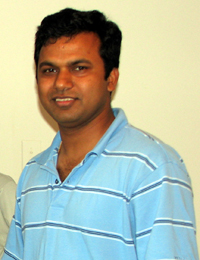Dr. Victor L. Pushparaj
The Times of India article NRI doc builds artificial muscle said
“Today’s most promising artificial muscles are based on electroactive polymers (EAPs) – plastics that change shape when activated electrically or with chemicals. But they lack mechanical robustness and as a result soon succumb to fatigue and fail.To test the nanotubes ability to resist fatigue, the team led by Victor Pushparaj took a two-millimeter-square block in which many millions of nanotubes were aligned vertically, and repeatedly compressed it between two steel plates once every 0.75 seconds for over 100 hours.
The team found that even after 500,000 compressions, in which the tubes were repeatedly squashed to 75 per cent of their original length, the block kept pinging back almost to its original shape.
‘The nanotubes buckled in a zig-zag shape but regained their original shapes when the load was released. The nanotubes buckled but regained their original shapes,’ said Pushparaj.”
Victor L. Pushparaj, Ph.D. is Senior Research Specialist, Rensselaer Polytechnic Institute. His research interests include carbon nanotubes (CNTs) for energy storage applications (supercapacitor, battery and hybrids), aligned CNT blocks for tactile sensors, fabrication of nanoFETs using CNTs for different applications, growth and understanding properties of CNTs, architectures of CNTS and carbon nanoparticles, synthesis and characterization of metal and oxide nanoparticles, and fatigue and retention properties of CNTs.
Victor coauthored Preparation of Biopolymer Fibers by Electrospinning from Room Temperature Ionic Liquids, Directed Growth and Electrical- Transport Properties of Carbon Nanotube Architectures on Indium Tin Oxide Films on Silicon-Based Substrates, Contact transfer of aligned carbon nanotube arrays onto conducting substrates, Synthesis of Silica-Gold Nanocomposites and Their Porous Nanoparticles by an In-Situ Approach, Development of Nanostructured Electron Microscopy Grids for Time Resolved Single Particle Reconstruction for Transmission Electron Microscopy, and Fatigue resistance of aligned carbon nanotube arrays under cyclic compression. Read his full list of publications!
He earned his Ph.D. with his thesis Pulsed laser ablation grown Zirconium Titanate and Barium Calcium Titanate thin films in MIM and MIS structures for high frequency and FeRAM applications at the Indian Institute of Science, Bangalore, India in 1994. He was selected for the prestigious Japan society for promotion of Science (JSPS 2004) fellowship to carry out post doctoral research at the Tokyo Institute of Technology, Tokyo, Japan.
Listen to his Earth & Sky interview Are synthetic muscles in our future?.
